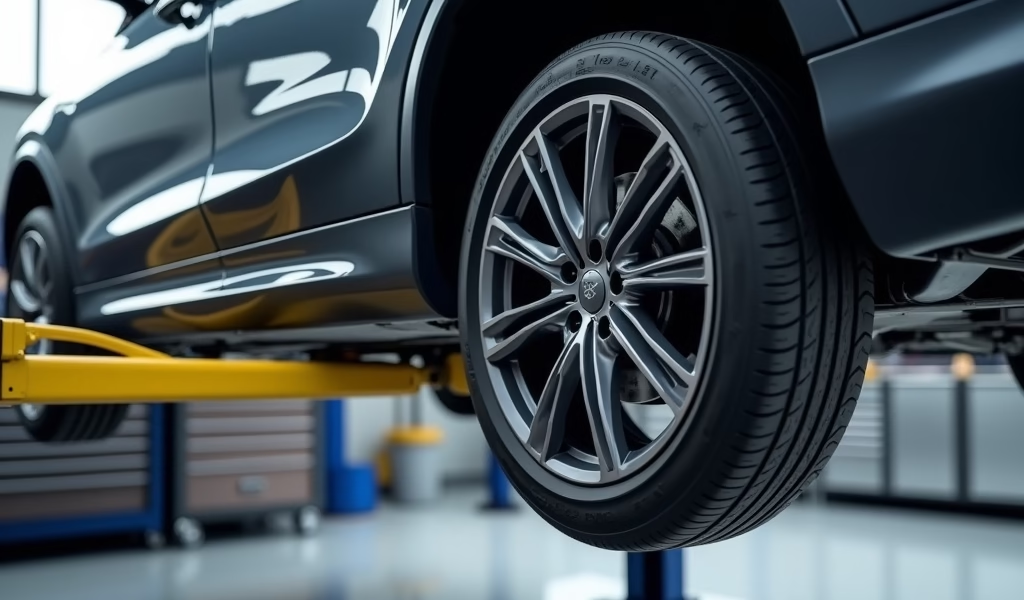Overview
This article explains that wheel speed sensor air gaps, the tiny space between sensors and tone rings (0.020-0.040 inches), are critical for proper functioning of vehicle safety systems like ABS and traction control. When incorrect, these gaps trigger warning lights and compromise safety, but can be diagnosed with feeler gauges and fixed through careful adjustment or shimming, though some situations require professional assistance.
Table of Contents
- Understanding Wheel Speed Sensors
- What is the Air Gap?
- Symptoms of Incorrect Air Gap
- Diagnosing Air Gap Problems
- Tools Needed for the Job
- Fixing Wheel Speed Sensor Air Gap
- Maintenance Tips
- When to See a Professional
- Conclusion
- Frequently Asked Questions
Understanding Wheel Speed Sensors
If you’ve ever had your ABS light pop on unexpectedly, you might be dealing with a wheel speed sensor air gap issue. These sensors are the unsung heroes of your vehicle’s safety systems, quietly monitoring how fast each wheel spins and reporting back to your car’s computer.
Wheel speed sensors serve as crucial components in modern vehicles, providing data to your anti-lock braking system (ABS), traction control system, and stability control. When you hit the brakes hard on a slippery road, it’s these sensors that tell your ABS which wheels are about to lock up, preventing a skid and helping you maintain control.
There are two main types of wheel speed sensors you’ll encounter:
- Passive sensors (magnetic): These older-style sensors generate their own AC voltage signal based on a toothed ring’s movement past the sensor.
- Active sensors (Hall effect): These newer digital sensors require power from the vehicle to operate and provide more precise readings, even at very low speeds.
Regardless of type, all wheel speed sensors have one thing in common: they need a specific air gap to function correctly. Get this wrong, and your vehicle’s safety systems might not work when you need them most.
What is the Air Gap?
The air gap is exactly what it sounds like—the small space between the tip of your wheel speed sensor and the tone ring (also called a reluctor ring) that it reads. This tiny distance is crucial for proper sensor operation.

Think of it like reading a book—if you’re too far away, you can’t see the words clearly. Too close, and your nose hits the page. Your wheel speed sensor needs that “just right” distance to accurately read the passing teeth or magnetic indicators on the tone ring.
Most vehicles require an air gap between 0.020 and 0.040 inches (0.5-1.0mm). That’s thinner than a credit card! The exact specification varies by make and model, which is why it’s always best to check your vehicle’s service manual for the precise measurement.
When this gap isn’t correct, several issues can arise:
- Too wide: The sensor may fail to detect wheel movement properly
- Too narrow: The sensor might contact the tone ring, causing damage to both components
- Inconsistent: Can create erratic readings that confuse your vehicle’s systems
Common causes of incorrect air gaps include bearing wear, bent mounting brackets, debris buildup, previous improper repairs, or damage from road hazards. Even normal driving can gradually change this gap as components wear or shift.
Symptoms of Incorrect Air Gap
How do you know if your wheel speed sensor air gap is incorrect? Your vehicle will usually let you know through several telltale signs:
- ABS light illuminated on your dashboard
- Traction control light coming on (or system not working properly)
- Stability control warning lights or unexpected system intervention
- Erratic or non-functioning speedometer readings
- Unexpected ABS activation during normal braking
- Cruise control that disengages randomly
I once had a customer with a Ford F-150 who complained that his truck would suddenly reduce power during acceleration on perfectly dry roads. After checking, we found that a wheel speed sensor with an incorrect air gap was falsely triggering the traction control system. The truck’s computer thought a wheel was slipping when it wasn’t!
These symptoms are your vehicle’s way of saying, “Hey, I’m getting confusing information about wheel speeds!” Don’t ignore them—proper wheel speed information is critical for the electronic brake force distribution and other safety systems to function correctly.
Diagnosing Air Gap Problems
Before diving into repairs, you’ll need to confirm that the air gap is actually the problem. Here’s my step-by-step approach to diagnosing wheel speed sensor air gap issues:
First, connect an OBD-II scanner to retrieve any trouble codes. Look for codes related to wheel speed sensors, typically in the C0XXX range. Codes like “C0035 Left Front Wheel Speed Sensor Circuit” point you directly to the problem area.
Next, visually inspect the sensor and its wiring. Look for obvious damage, disconnected plugs, or wiring that’s been rubbed through. Wheel speed sensors often live in harsh environments near your brakes and suspension, where they’re exposed to road debris and heat.
The physical inspection comes next:
- Jack up the vehicle and secure it on jack stands
- Remove the wheel for better access
- Locate the wheel speed sensor (usually mounted to the steering knuckle, brake backing plate, or inside the hub assembly)
- Check for damage, corrosion, or debris around the sensor
- Examine the tone ring for damaged or missing teeth (you may need a small inspection mirror)
For accurate measurement, you’ll need feeler gauges to check the actual air gap. According to Motor Magazine’s technical analysis, the correct air gap is critical for sensor signal quality. Insert the appropriate size gauge between the sensor tip and tone ring—it should slide with slight resistance.
Compare your measurement with the specification in your service manual. If it’s outside the recommended range, you’ve found your culprit!
Tools Needed for the Job
Fixing wheel speed sensor air gaps doesn’t require exotic tools, but you do need the right ones for the job. Here’s what I keep handy:
- Basic hand tools (socket set, wrenches, screwdrivers)
- Jack and jack stands (never work under a vehicle supported only by a jack!)
- Feeler gauges (non-metallic preferred for sensor work)
- Wire brush for cleaning mounting surfaces
- Brake cleaner or electrical contact cleaner
- Torque wrench (proper torque prevents future problems)
- OBD-II scanner for reading and clearing codes
- Factory service manual or reliable online repair database
If you’re dealing with a reluctant sensor or need to remove rust, a penetrating oil like PB Blaster can be helpful. Just be careful to keep it away from brake surfaces.
For the actual gap adjustment, you might need shims or spacers, depending on your vehicle. Some manufacturers sell specific adjustment kits, while for others, you might need to make your own non-conductive shims from appropriate materials.
A digital multimeter is also handy for testing sensor output if you want to be thorough. It can tell you if the sensor is generating the proper signals once you’ve adjusted the gap.

Fixing Wheel Speed Sensor Air Gap
With diagnosis complete and tools in hand, it’s time to fix that air gap! The approach varies slightly depending on your vehicle type, but here’s the general process:
For Adjustable Sensors:
Many sensors allow for adjustment by loosening mounting bolts and repositioning. Here’s how to do it right:
- Ensure the vehicle is safely supported and the wheel is removed
- Locate the sensor mounting bolts and loosen them just enough to allow movement (don’t remove completely)
- Select the appropriate feeler gauge based on your vehicle specifications
- Place the gauge between sensor tip and tone ring
- Gently slide the sensor until it contacts the feeler gauge
- While maintaining position, tighten mounting bolts to specification
- Remove the feeler gauge and rotate the hub to ensure no contact throughout rotation
For example, on many GM vehicles, the correct procedure involves loosening the sensor, inserting a 0.030″ feeler gauge, pushing the sensor until it contacts the gauge, then tightening to 97 inch-pounds of torque. Always follow your specific vehicle’s requirements.
For Non-Adjustable Sensors:
Some sensors, particularly on newer vehicles, don’t have adjustment provisions. For these:
- Remove the sensor completely
- Clean the mounting hole and sensor thoroughly
- Check for debris or damage that might prevent proper seating
- If the gap is too large, you may need to use appropriate shims
- Reinstall the sensor and torque to specification
I once worked on a Nissan Altima where the sensor wasn’t adjustable, but the air gap was too wide. The solution was to add a thin non-conductive shim between the sensor body and mounting bracket. Be creative but careful—you’re dealing with safety-critical components.
After adjustment, clear any stored trouble codes with your scanner and test-drive the vehicle. The warning lights should remain off, and systems like ABS and traction control should function normally. Research from SAE International shows that properly calibrated sensors significantly improve ABS performance in emergency situations.
Maintenance Tips
Preventative maintenance can save you from future wheel speed sensor headaches. Here are my top tips:
- When rotating tires (every 5,000-7,500 miles), visually inspect wheel speed sensors and wiring for damage or debris
- Keep brake components clean—excessive brake dust can contaminate sensors
- When replacing brake rotors, pads, or bearings, always check and adjust wheel speed sensor air gaps
- Apply a small amount of dielectric grease to sensor connectors to prevent corrosion
- In areas with heavy winter road salt, rinse wheel wells and underbody regularly to prevent corrosion
I’ve seen many sensors fail simply because their connectors corroded. A little dielectric grease is cheap insurance against expensive repairs down the road.
Be particularly vigilant after hitting large potholes or road debris—these impacts can bend components and change air gaps. A quick visual inspection can catch problems before they affect your safety systems.
When to See a Professional
While many wheel speed sensor air gap issues can be handled by a capable DIYer, some situations call for professional help:
- If the tone ring is damaged and requires replacement (often part of a hub assembly)
- When sensors are located inside sealed hubs requiring special tools
- If adjusting the air gap doesn’t resolve warning lights
- When multiple sensors are showing problems simultaneously (might indicate a system issue)
- If your vehicle has advanced driver assistance systems that require calibration after sensor work
Modern vehicles increasingly integrate wheel speed data into complex safety systems. According to industry experts, even basic repairs can necessitate recalibration of advanced safety systems.
Don’t hesitate to seek help if you’re unsure. The cost of professional service is far less than the potential consequences of improperly functioning safety systems when you need them most.
Conclusion
Wheel speed sensor air gaps might be tiny, but they play an outsized role in your vehicle’s safety systems. By understanding how they work, recognizing the symptoms of problems, and knowing how to properly adjust them, you’re taking an important step toward maintaining your vehicle’s safety systems.
Remember that precise measurements matter—we’re talking about gaps thinner than a credit card that can make the difference between your ABS working properly in an emergency or not. Take your time, use the right tools, and follow specifications.
Regular inspection and maintenance of these sensors is a small investment that pays big dividends in safety and reliability. Whether you tackle the job yourself or seek professional help, addressing wheel speed sensor air gap issues promptly ensures your vehicle’s critical safety systems will be there when you need them most.
The next time your ABS light comes on, you’ll have the knowledge to determine if a simple air gap adjustment might be the solution—potentially saving yourself time, money, and the headache of unnecessary parts replacement.
Frequently Asked Questions
What is the ideal wheel speed sensor air gap?
Most vehicles require an air gap between 0.020 and 0.040 inches (0.5-1.0mm), but always check your specific vehicle’s service manual for exact specifications. Different makes and models have different requirements.
Can I drive with an incorrect wheel speed sensor air gap?
It’s not recommended as it may compromise safety systems like ABS, traction control, and stability control. Your vehicle might be safe for careful driving to a repair facility, but fix the issue promptly.
How often should I check wheel speed sensor air gaps?
Check them when rotating tires (every 5,000-7,500 miles) and whenever you service brake components or suspension parts. Any work that could affect wheel hub positioning might change the air gap.
Will a bad wheel speed sensor air gap cause the check engine light to come on?
Typically, it triggers the ABS or traction control warning lights rather than the check engine light. However, some vehicles may illuminate the check engine light if the speed sensor data affects transmission or engine management.
Can wheel bearing wear affect the sensor air gap?
Yes, worn wheel bearings allow excessive movement of the hub assembly, which can change the air gap between the sensor and tone ring. This is one reason to address wheel bearing wear promptly.

